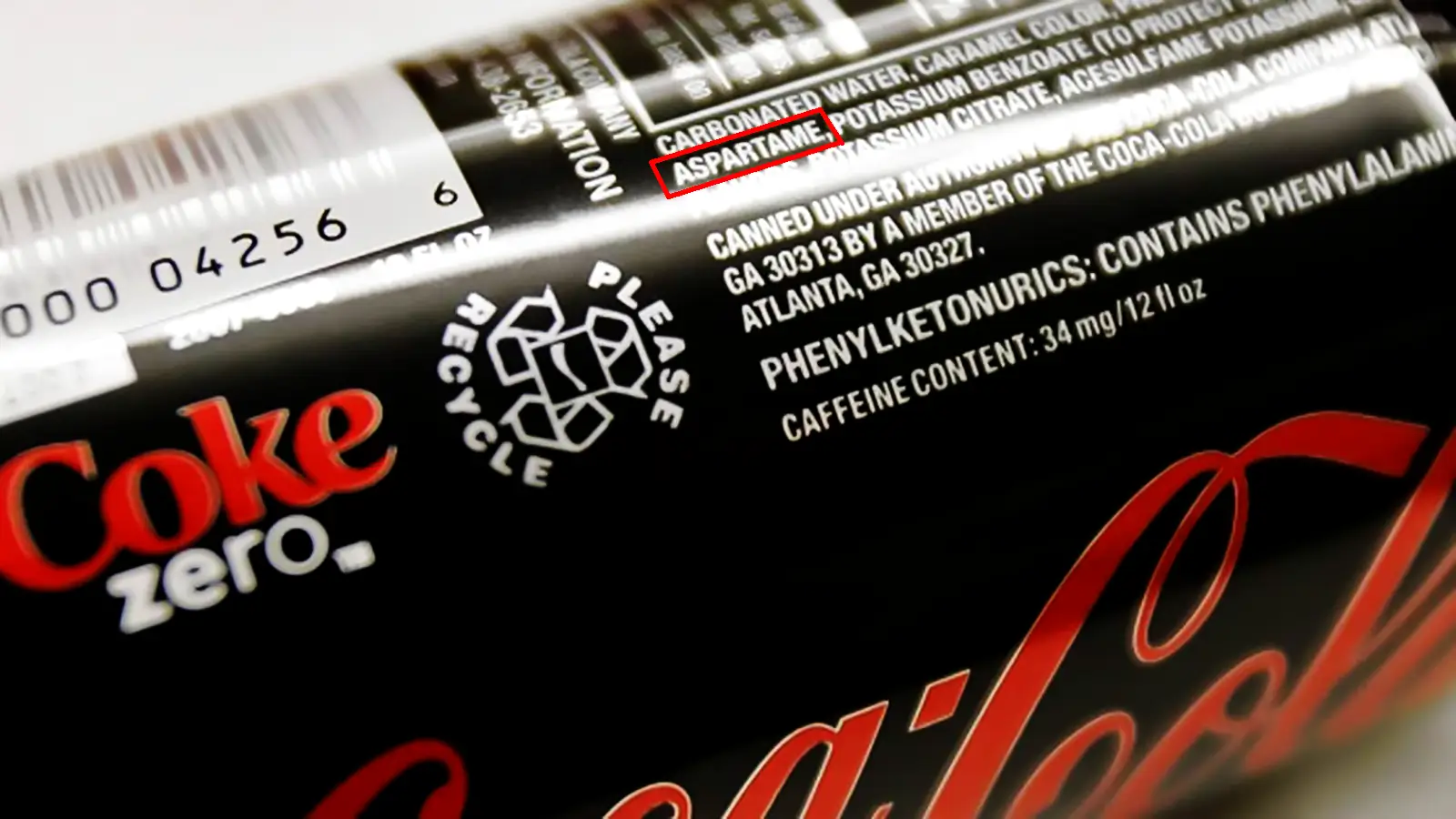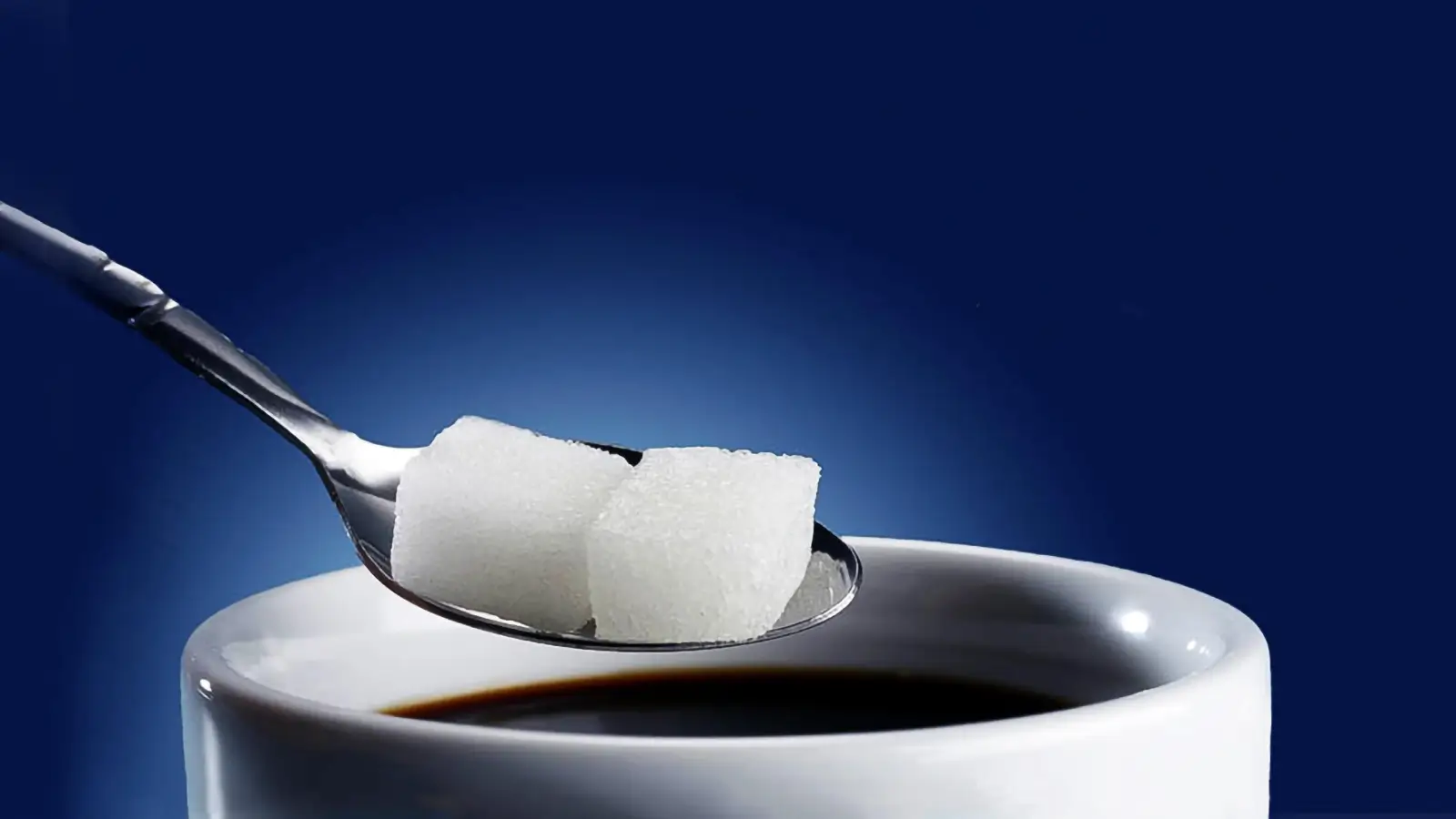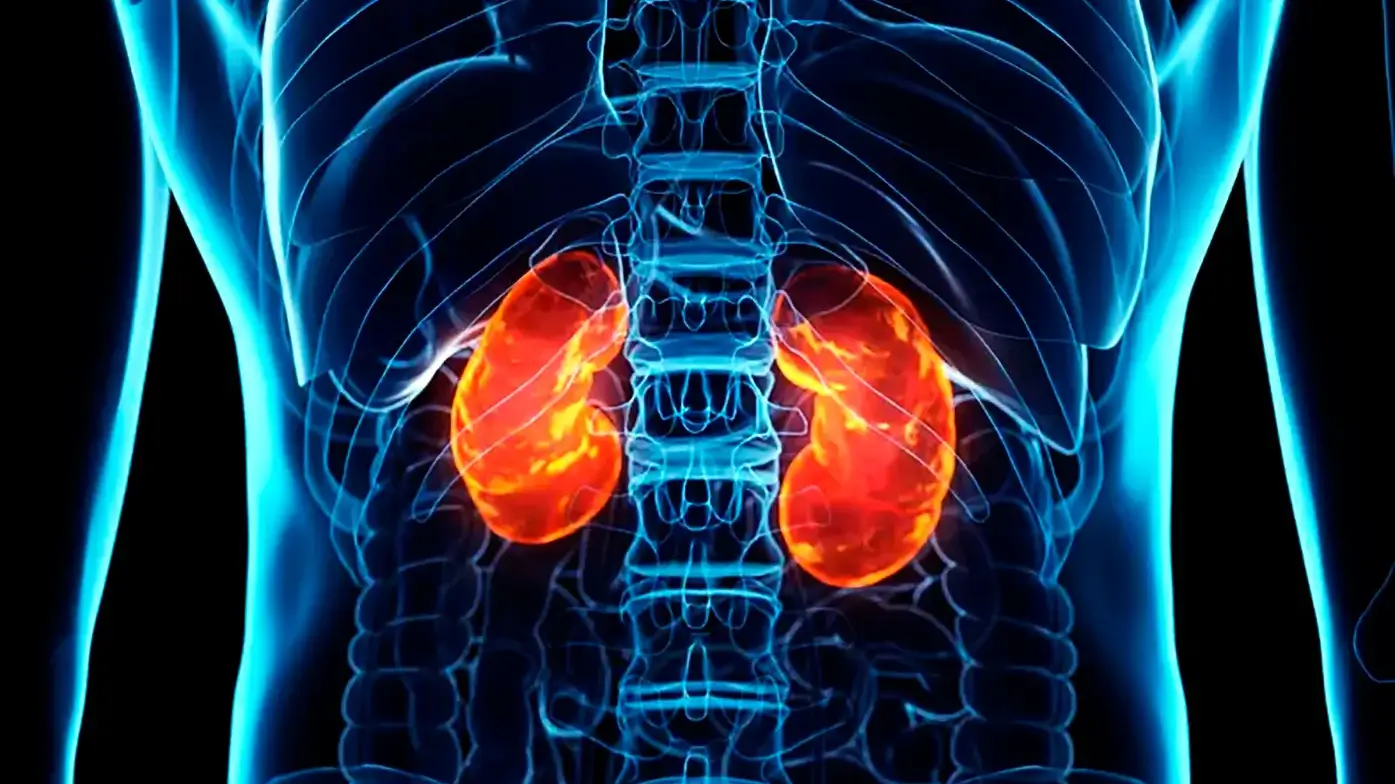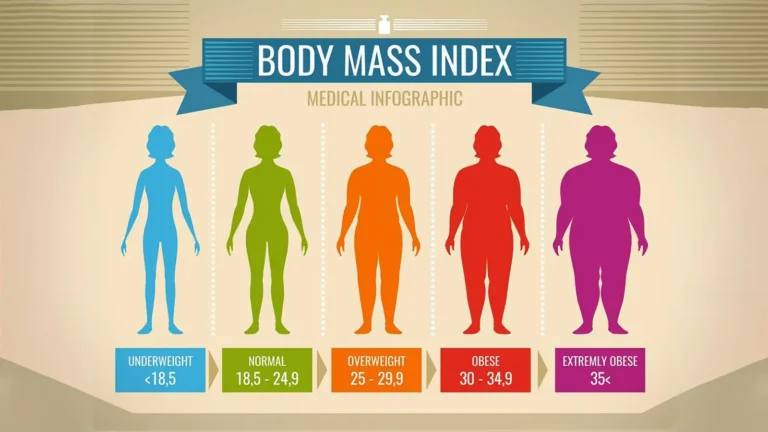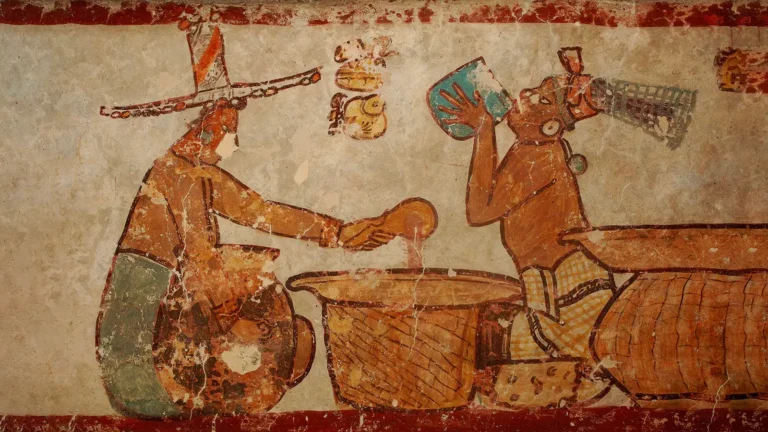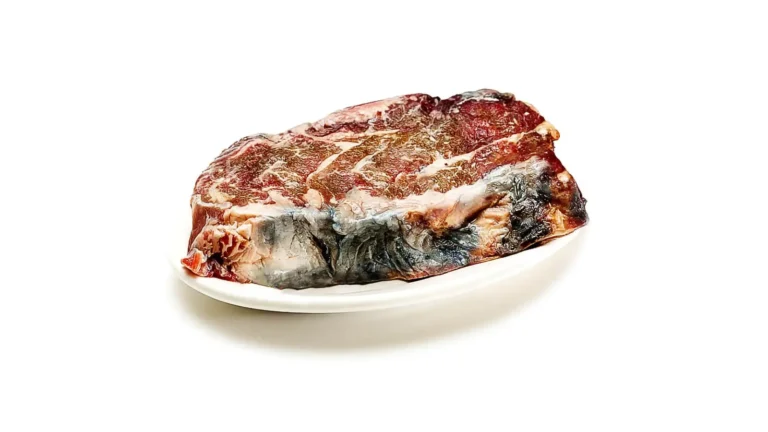Leche A1: Diabetes, Autismo y Cardiopatías
La leche A1 con la variante beta-caseína a1 es un posible factor de riesgo en el desarrollo de diabetes tipo 1 en niños, autismo y enfermedades cardiacas en adultos.
Milos Pokimica
Escrito por: Milos Pokimica
Revisado Médicamente Por: Dr. Xiùying Wáng, M.D.
Actualizado el 10 de junio de 2023Principales Conclusiones:
- La beta-caseína es una proteína que constituye aproximadamente el 30% de la proteína de la leche de vaca. Existe en dos variantes genéticas: A1 y A2.
- A1 beta-caseína en la leche de vaca es diferente de todos los demás mamíferos, que tienen exclusivamente el tipo A2 incluyendo el ganado A2 de la India, y África, Búfalo, al igual que otros mamíferos y la misma que la leche humana. Casi todos los bovinos del tipo A1 están relacionados con las vacas de origen europeo para la subespecie de la especie original de esta mutación Bos Taurus.
- El BCM7 es un péptido que se descompone a partir de la beta-caseína A1 en 7 aminoácidos. Tiene efectos parecidos a los opiáceos, similares a los de narcóticos como la morfina, y puede ser perjudicial para las lipoproteínas de baja densidad (LDL).
- Existe una correlación entre la diabetes de tipo 1 y los anticuerpos contra la beta-caseína A1. Se cree que estos anticuerpos atacan a las células que producen insulina en el páncreas debido a las similitudes con la estructura proteica de BCM7.
- Las casomorfinas son opioides que pueden encontrarse en los productos lácteos, concretamente en la beta-caseína A1. Se han relacionado con el autismo y la esquizofrenia a través de la teoría del "exceso de opioides".
- Los péptidos opiáceos de la leche de vaca se han teorizado durante mucho tiempo como posible causa del síndrome de muerte súbita del lactante (SMSL), ya que pueden inhibir el centro respiratorio del tronco encefálico, lo que provoca apnea y muerte.
- Se observó un irBCM basal elevado (casomorfinas bovinas) en lactantes alimentados con leche artificial que presentaban un retraso en el desarrollo psicomotor y un tono muscular elevado, mientras que el irHCM basal más elevado (casomorfinas humanas) se observó en lactantes alimentados con leche materna con un desarrollo psicomotor y un tono muscular normales.
Beta-caseína A1 en la leche de vaca.
La beta-caseína constituye aproximadamente el 30% de la proteína de la leche de vaca. La beta-caseína está presente en una o dos variantes genéticas: A1 o A2. La mayor parte de la leche de vaca contiene una combinación de beta-caseína A1 y A2. Sin embargo, en algunos países existe leche que sólo contiene el tipo A2 sin beta-caseína A1 alfa.
La segunda variante, la beta-caseína A2, no está asociada a la diabetes de tipo 1.
La relación establecida de este vínculo entre la beta-caseína A1 y la diabetes de tipo 1, y las enfermedades cardiacas es de 0,982 y 0,76 (Laugesen y Elliott, 2003).
Se trata de un nivel muy significativo si se compara con otras razones epidemiológicas de estas afecciones, como el tabaquismo y la mortalidad por cáncer de pulmón r = 0,73 o la probabilidad de que las personas en la década de 1960 y las afecciones cardiacas diez años después donde r = 0,85.
La diferencia entre la beta-caseína A1 y A2 se debe a una única sustitución de aminoácidos en la línea 67 de aminoácidos de 209 que tienen en la cadena.

A1 beta-caseína en la leche de vaca es diferente de todos los demás mamíferos, que tienen exclusivamente el tipo A2 incluyendo el ganado A2 de la India, y África, Búfalo, al igual que otros mamíferos y la misma que la leche humana. Casi todos los bovinos del tipo A1 están relacionados con las vacas de origen europeo para la subespecie de la especie original de esta mutación Bos Taurus.
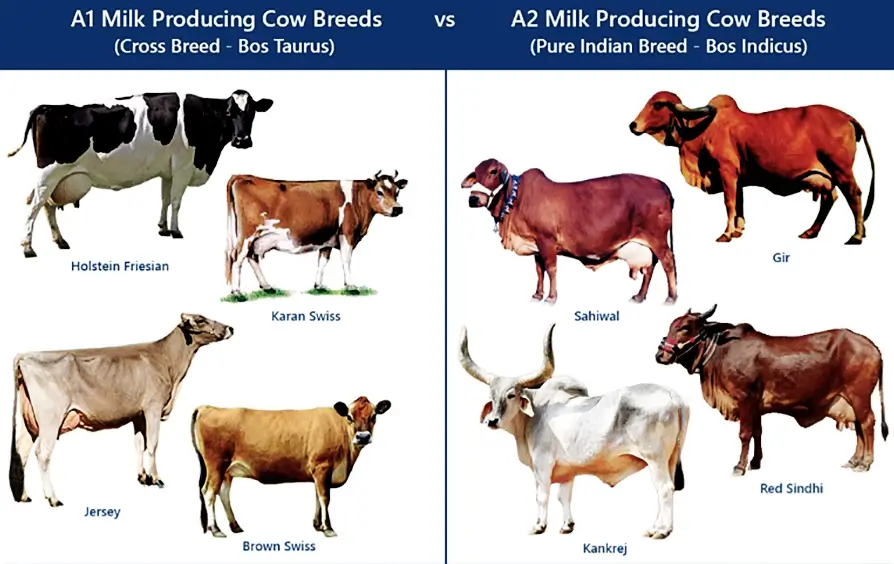
Es el resultado de una mutación genética en las vacas de Europa que ocurrió hace unos 8.000 años. Hoy en día, las vacas lecheras A1 se crían en Europa y América, y las especies A2 en Nueva Zelanda. La especie Holstein tiene beta-caseína A1 y A2 en cantidades casi iguales. La especie Jersey suele tener un poco más de A2, pero también se considera una especie mixta. Las mismas vacas Jersey llevan una beta-caseína "B" que ha demostrado dar más BCM7. Signo de una mala fijación de la histidina, la beta-caseína A1 se descompone en péptidos de 7 aminoácidos llamados beta casomorfina 7 (BCM7) cuando se consume. BCM7 es problemático porque el opiáceo está al mismo nivel que narcóticos como la morfina y tiene efectos similares. También es un oxidante que se sabe que es perjudicial para lipoproteínas de baja densidad (LDL). Debido a que los enlaces entre 7 aminoácidos lo hacen extremadamente fuerte, es resistente a una mayor degradación. Cuando el BCM7 entra en el torrente sanguíneo, surgen varios problemas.

Sin embargo, la BCM 7 es demasiado grande para ser absorbida por una capa sana en el intestino, lo que significa que el problema de salud asociado a la beta-caseína A1 es más probable en personas con una salud digestiva dañada o por enfermedades como enfermedad celíaca o enfermedad gastrointestinal.
Si usted tiene un intestino permeable, entonces usted puede dar a sí mismo ya su feto si está embarazada la diabetes tipo 1 como una enfermedad autoinmune. si usted consume leche y productos lácteos, es decir. Las personas que padecen alguna de las afecciones anteriores son más propensas al absceso BCM7. En los bebés que presentan de forma natural un aumento de la permeabilidad intestinal para mejorar la absorción de nutrientes, el riesgo también es mayor.
Una vez que entra en el torrente sanguíneo, el BCM7 puede atravesar fácilmente la barrera hematoencefálica y entrar en el cerebro, donde la conexión con los receptores provoca los síntomas del autismo y la esquizofrenia.
Esta afirmación se inició a raíz de una investigación difundida en ratas, en la que éstas mostraron tendencias de comportamiento y simpatía similares a las del autismo y la esquizofrenia tras la inyección de BCM7. La asociación de estos efectos también se confirmó por la capacidad de revertir el estado y los cambios en el comportamiento opiáceo-antagonista de la naloxona. Además, desde hace tiempo se reconoce que los opiáceos tienen un efecto sobre función inmunitaria, que es la posible razón por la que la beta-caseína A1 y la BCM7 se asocian a enfermedades autoinmunitarias..
Enfermedades del corazón.
El primer descubrimiento lo hizo Alexandra Steinerovath, que ha estado investigando las razones del estrés oxidativo en los lactantes. Descubrió que los bebés alimentados con leche artificial tenían un mayor nivel de anticuerpos contra las LDL oxidadas (Steinerová et al, 1999). En 2004, Steinerova propuso la idea e hizo un estudio sobre la BCM7 y el aumento de anticuerpos en los lactantes. Un estudio demostró que los lactantes alimentados con preparados para lactantes con beta-caseína A1 desarrollaban niveles significativamente más altos de estos anticuerpos en comparación con los alimentados con beta-caseína A2 (Steinerová et al., 2004).
Hoy en día se han realizado más investigaciones y la comunidad científica admite que el BCM7 tiene un efecto prooxidante sobre las LDL. En el caso de las enfermedades cardiacas, estudios adicionales han descubierto el mecanismo por el cual la beta-caseína A1 desarrollará la enfermedad cardiacaque oxida las LDL que transportan el colesterol del hígado a los tejidos (Chin-Dusting et al., 2006). Esto es importante porque las LDL oxidadas aumentan el riesgo de enfermedad cardiaca como resultado de una mayor incidencia en las arterias y, como consecuencia, una mayor acumulación de placa, es decir, las LDL oxidadas hacen que las arterias se vuelvan pegajosas y conducen a la formación de placa.
Diabetes tipo 1.
La diabetes de tipo 1, se clasifica como una enfermedad autoinmune que se produce debido a una agresión del sistema inmunitario a las células que producen insulina en el páncreas.
Y no es genético como podría hacer creer la medicina convencional. La predisposición genética desempeña un papel, pero para demostrar que se trata de una inadaptación más podemos fijarnos en los gemelos idénticos. La concordancia de la diabetes tipo 1 en gemelos idénticos es sólo del 50 %. Es decir, uno la padece y el otro no. Si es genético y el medio ambiente no juega un papel que no sucedería. Es algo que comimos o, para ser precisos, que las madres comieron o dieron a los bebés lo que les hace desarrollar esta enfermedad autoinmune.
En Japón la diabetes tipo 1 es 18 veces menor que en EE.UU., pero cuando los japoneses emigran a América y empiezan a adoptar la dieta occidental, desarrollan el mismo índice de diabetes que los estadounidenses. Algunos países tienen 100 veces menos tasas de diabetes tipo 1 que otros, dependiendo sobre todo de la dieta que siga la población. La diabetes tipo 1 empezó a aumentar después de la Segunda Guerra Mundial, al igual que otras enfermedades, así que no es genética. Se trata de una mala adaptación, y ahora sabemos cuál es su causa.
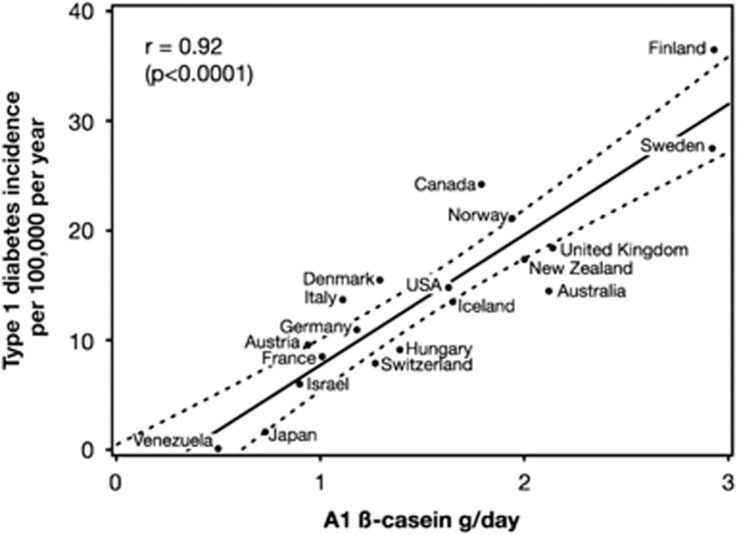
En 1999, los expertos en Alemania descubrió que existe una correlación entre la diabetes de tipo 1 y el nivel de anticuerpos contra la beta-caseína A1. Se cree que estos anticuerpos se basan, de hecho, en la secuencia de aminoácidos del opiáceo problemático BCM7, derivado de la beta-caseína A1. Como la secuencia tiene similitudes con la estructura proteica de las células que producen insulina en el páncreas, los anticuerpos atacan al páncreas junto con los péptidos BCM7. En este estudio, todos los niños presentaban niveles significativos de anticuerpos contra la beta-caseína A1 en la sangre, pero no de anticuerpos contra otras proteínas de la leche (Karjalainen et al., 1992). La conclusión fue:
"Los pacientes con diabetes mellitus insulinodependiente presentan inmunidad frente a la albúmina de la leche de vaca, con anticuerpos contra un péptido de la albúmina capaz de reaccionar con una proteína de superficie específica de las células beta. Tales anticuerpos podrían participar en el desarrollo de la disfunción de los islotes".
Karjalainen et al., 1992

Autismo, Esquizofrenia, y Síndrome de muerte súbita del lactante.
Además, hay opiáceos que atraviesan la barrera hematoencefálica. Debido a que los opiáceos BCM7 no debería estar presente en absoluto y representan una forma de mutación no natural en el ganado no debería ser una gran sorpresa en la relación entre la beta-caseína A1 y caseína en general a la asociación con el autismo también.

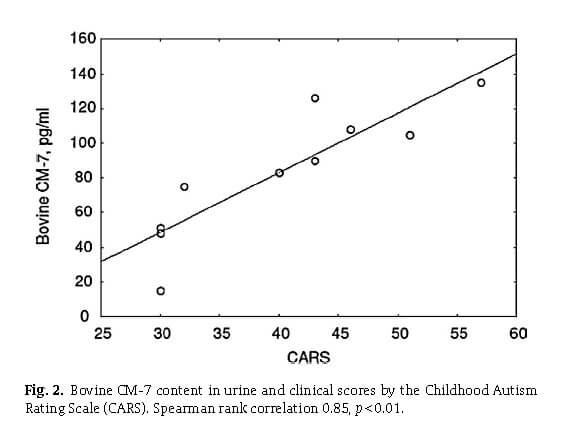
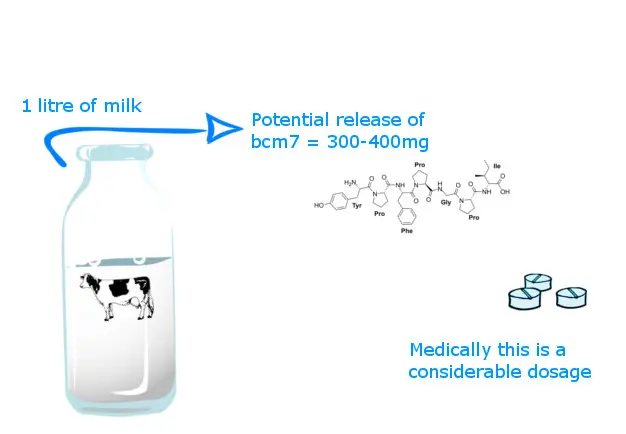
El BCM 7 obtenido de la beta-caseína A1 y la gluteomorfina derivada del gluten son opiáceos que pueden asociarse a estos síntomas. Debido a esto, un gran número de niños con autismo muestran mejoras significativas si evitan el gluten y la caseína. La relación entre autismo y opiáceos no es nada nuevo. En 1979, Jaak Panksepp, científico, sugirió esa conexión. En 2000, un equipo de investigadores dirigido por Robert Cade revisó las pruebas existentes que relacionaban la caseína y la gluten opiáceos con el autismo y la esquizofrenia. Recogieron nuevos datos de 150 niños autistas, 120 adultos con esquizofrenia, 43 niños normales y 76 adultos normales (Cade et al., 2000). Los niños autistas y los adultos esquizofrénicos mostraron un valor anormal elevado constante de los péptidos opioides casomorfina y gluteomorfina obtenidos a partir de beta-caseína y gluten.
En realidad, todos los adultos muestran niveles elevados de esta sustancia opioide morfina tras el consumo de leche o yogur, incluso el adulto que no presenta inflamación en el intestino al menos durante las 8 horas posteriores al consumo (Chabance et al., 1998).
La teoría es más o menos así. Usted tiene una predisposición genética a padecer enfermedades como el autismo o la esquizofrenia. Es la llamada "exceso de opiáceos"Teoría. Usted tiene una predisposición genética y luego tiene una exposición temprana a factores ambientales estresantes que dañan su intestino y lo hacen permeable o usted es simplemente un bebé normal que naturalmente tiene un intestino permeable. Luego viene la leche o los productos lácteos con todas las casomorfinas que se filtran en la sangre en exceso y luego en el cerebro desencadenando la formación de la enfermedad. Se cree que estos opioides podrían desempeñar uno de los papeles en el desarrollo del autismo y otros trastornos neurológicos. El problema con estas casomorfinas es también que cuando se examina la barrera hematoencefálica de los pacientes con autismo, su barrera hematoencefálica también parece más débil.
En un individuo normal, va a haber algunos de los efectos sedantes, pero en alguien con un intestino permeable y una barrera hematoencefálica permeable que va a tener un efecto mucho más fuerte, y si esa persona tiene una predisposición genética o sensibilidad a ella, entonces la enfermedad real puede formar. Según la teoría del "exceso de opioides".
De los setenta niños autistas sometidos a una dieta sin gluten y sin caseína, 81% mostraron mejoras significativas en un periodo de 3 meses, y más de un tercio de los que no se recuperaron seguían teniendo niveles elevados de péptidos opiáceos, lo que indica que no mantuvieron la dieta del niño. Aunque sólo 40% de los adultos han mejorado, se cree que muchos de ellos no han seguido la dieta durante el tiempo suficiente para proporcionar a sus cuerpos la capacidad de eliminar las moléculas de BCM7 existentes en el cerebro que pueden durar más de un año.
En 1999, Zhongjie Sun y Robert Cade inyectaron en ratas derivados opioides BCM7 de la beta-caseína A1 para determinar si entraban en el cerebro (Cade et al., 1999). Descubrieron que entraría en las diversas áreas del cerebro que anteriormente se había demostrado que estaban asociadas con el autismo y la esquizofrenia. En consecuencia, se razonó que el BCM7 podría atravesar la barrera hematoencefálica y llegar a partes del cerebro susceptibles de verse afectadas por el autismo y la esquizofrenia. Ese mismo año, realizaron un experimento similar y descubrieron que las ratas inyectadas con BCM7 presentaban varios síntomas significativos de autismo y esquizofrenia, como intolerancia, menor sensibilidad al dolor y falta de respuesta a estímulos externos.
En 2003, Sun y Cade continuaron sus investigaciones y descubrieron que los opiáceos gluteomorfina derivados del gluten afectan sólo a tres regiones del cerebro, mientras que los opiáceos BCM7 derivados de la beta-caseína A1 afectan a 45 regiones y la circulación de este péptido en el sistema nervioso central inmaduro del lactante podría inhibir también el centro respiratorio en el tronco encefálico provocando apnea y muerte (Sun et al, 2003). Los péptidos opiáceos de la leche se han teorizado durante mucho tiempo como una posible causa de síndrome de muerte súbita del lactante (Ramabadran and Bansinath, 1988).
Esto no sólo demostró que BCM7 llega al cerebro mucho más fácilmente, sino que es un factor mucho mayor en el desarrollo de autismo y esquizofrenia. No sé si estos estudios conducirán a una mayor comprensión o a un mejor tratamiento de estas personas. Podría haber individuos con una predisposición genética a estas enfermedades que estas proteínas de mimetismo molecular no hacen sino agravar. No lo sé. La ciencia sigue investigando, pero es un proceso lento y ¿quién tendrá interés en financiar estos estudios? Llevará algún tiempo.
Casomorfinas opoides y retraso psicomotor.
La leche A1 frente a la A2 llegó a ser un gran problema político en Australia y Nueva Zelanda. Acabó con el etiquetado obligatorio de la leche y todos los productos lácteos. En Australia, no se puede comprar una botella de leche A1 o de cualquier otro producto lácteo sin una etiqueta visible que indique si la leche contiene una forma de proteína A1 o A2.

¿Por qué están estos opiáceos en la leche en primer lugar? Y los hay en toda la leche existente, no sólo en la variante A1. La leche A1 es sólo una variante más potente. Para los bebés humanos normales, así como para los terneros, están ahí para crear un ansia o para hacerlos adictos como lo son los drogadictos normales, pero en este caso, la adicción va a desencadenar la curación del bebé para los opiáceos y entonces el bebé va a obtener toda la nutrición de la leche que necesita para crecer. Todo es como debería ser, pero ahora hemos cambiado de especie. Al igual que el perfil de aminoácidos de la proteína de la leche humana y de vaca no es el mismo, el perfil de estas casomorfinas no es el mismo.
En este estudio (Kost et al., 2009) los bebés alimentados con leche de vaca con un nivel más alto de casomorfinas bovinas parecen sufrir retraso psicomotor, pero se descubrió exactamente lo contrario en el caso de las casomorfinas humanas. Las casomorfinas humanas parecen ayudar al cerebro de los humanos. La conclusión del estudio fue:
"El irHCM basal más elevado (casomorfinas humanas) se observó en lactantes alimentados con leche materna con un desarrollo psicomotor y un tono muscular normales. Por el contrario, se observó un irBCM (casomorfinas bovinas) basal elevado en los lactantes alimentados con leche artificial que presentaban un retraso en el desarrollo psicomotor y un tono muscular elevado. Entre los lactantes alimentados con leche artificial con un desarrollo normal, el índice de este parámetro se correlacionaba directamente con el irBCM basal. Los datos indican que la lactancia materna tiene una ventaja sobre la alimentación artificial para el desarrollo de los lactantes durante el primer año de vida y apoyan la hipótesis del deterioro de la eliminación de las casomorfinas bovinas como factor de riesgo de retraso en el desarrollo psicomotor y otras enfermedades como el autismo."
(Kost et al., 2009)
La estructura de la caseína en la leche humana y de vaca es significativamente diferente igualando sólo en un 47%, y especialmente si tenemos caseína A1 mutada en la mezcla, entonces tenemos una situación que puede desencadenar la diabetes tipo 1 en el bebé. La casomorfina bovina es mucho más fuerte que la humana, y está casi al nivel de la morfina en su efecto (Trivedi y otros, 2015). Las casomorfinas de vaca se unen más estrechamente a los receptores de serotonina del cerebro que las humanas. Además, las casomorfinas opiáceas fueron producidas tanto por la leche A1 como por la A2 sin diferencias en cuanto a potencia (Asledottir et al., 2017). Además, hay mucha más caseína en general en la leche de vaca, 15 veces más para ser precisos que en la leche humana. En la leche de vaca se encontraron 21 péptidos y ocho de beta-caseína, y en la leche humana sólo cinco péptidos y uno de beta-caseína.

¿Debería pasarse a la A2, que es diez veces más cara? ¿Y la pizza con queso de leche A1 o cualquier otro producto comercial de leche A1? La mayoría de los chocolates se elaboran con leche en polvo A1. Lo más realista es que, aunque queramos pasarnos a la A2, no hay leche A2 en los alrededores si vivimos fuera de Nueva Zelanda. E incluso en Nueva Zelanda existe la leche en polvo A1 fabricada para los industria alimentaria en casi todo. Desde el helado hasta el chocolate. E incluso si pudiéramos gastar dinero adicional y tener ese helado A2, la leche sigue estando correlacionada incluyendo A2 a una amplia gama de problemas de salud (Leche y productos lácteos: correlaciones de riesgo para la salud).
El diablo de la leche, por qué puede ser peligrosa.
Preguntas Frecuentes
Referencias:
- Karjalainen, J., Martin, J. M., Knip, M., Ilonen, J., Robinson, B. H., Savilahti, E., Akerblom, H. K., & Dosch, H. M. (1992). A bovine albumin peptide as a possible trigger of insulin-dependent diabetes mellitus. El diario de Nueva Inglaterra de la medicina, 327(5), 302-307. https://doi.org/10.1056/NEJM199207303270502
- Chabance, B., Marteau, P., Rambaud, J. C., Migliore-Samour, D., Boynard, M., Perrotin, P., Guillet, R., Jollès, P., & Fiat, A. M. (1998). Casein peptide release and passage to the blood in humans during digestion of milk or yogurt. Biochimie, 80(2), 155-165. https://doi.org/10.1016/s0300-9084(98)80022-9
- Kost, N. V., Sokolov, O. Y., Kurasova, O. B., Dmitriev, A. D., Tarakanova, J. N., Gabaeva, M. V., Zolotarev, Y. A., Dadayan, A. K., Grachev, S. A., Korneeva, E. V., Mikheeva, I. G., & Zozulya, A. A. (2009). Beta-casomorphins-7 in infants on different type of feeding and different levels of psychomotor development. Péptidos, 30(10), 1854-1860. https://doi.org/10.1016/j.peptides.2009.06.025
- Trivedi, M. S., Hodgson, N., Walker, S. G., Trooskens, G., Nair, V., & Deth, R. C. (2015). Efectos epigenéticos de los péptidos opioides derivados de la caseína en células de neuroblastoma humano SH-SY5Y. Nutrición y metabolismo, 12(1). https://doi.org/10.1186/s12986-015-0050-1
- Asledottir, T., Le, T. T., Petrat-Melin, B., Devold, T. G., Larsen, L. B., & Vegarud, G. E. (2017). Identificación de péptidos bioactivos y cuantificación de β-casomorfina-7 de β-caseína bovina A1, A2 y I después de la digestión gastrointestinal ex vivo. Revista Internacional de Lechería, 71, 98-106. https://doi.org/10.1016/j.idairyj.2017.03.008
- Cade, R., Privette, M., Fregly, M., Rowland, N., Sun, Z., Zele, V., Wagemaker, H., & Edelstein, C. (2000). Autismo y esquizofrenia: trastornos intestinales. Neurociencia nutricional, 3(1), 57-72. https://doi.org/10.1080/1028415X.2000.11747303
- Pal, S., Woodford, K., Kukuljan, S., & Ho, S. (2015). Intolerancia a la leche, beta-caseína y lactosa. Nutrientes, 7(9), 7285-7297. https://doi.org/10.3390/nu7095339
- Chia, J. S. J., McRae, J. L., Kukuljan, S., Woodford, K., Elliott, R. B., Swinburn, B., & Dwyer, K. M. (2017). Proteína láctea beta-caseína A1 y otros factores ambientales predisponentes para la diabetes tipo 1. Nutrición y diabetes, 7(5), e274. https://doi.org/10.1038/nutd.2017.16
- Sun, Z., Zhang, Z., Wang, X., Cade, R., Elmir, Z., & Fregly, M. (2003). Relation of beta-casomorphin to apnea in sudden infant death syndrome. Péptidos, 24(6), 937-943. https://doi.org/10.1016/s0196-9781(03)00156-6
- Ramabadran, K., & Bansinath, M. (1988). Opioid peptides from milk as a possible cause of sudden infant death syndrome. Hipótesis médicas, 27(3), 181-187. https://doi.org/10.1016/0306-9877(88)90138-7
- Chin-Dusting, J., Shennan, J., Jones, E., Williams, C., Kingwell, B., & Dart, A. (2006). Effect of dietary supplementation with beta-casein A1 or A2 on markers of disease development in individuals at high risk of cardiovascular disease. El British journal of nutrition, 95(1), 136-144. https://doi.org/10.1079/bjn20051599
- Steinerová, A., Racek, J., Stozický, F., Tatzber, F., & Lapin, A. (1999). Autoanticuerpos contra LDL oxidadas en la primera fase de la vida. Lipoproteínas de baja densidad. Química clínica y medicina de laboratorio, 37(9), 913-917. https://doi.org/10.1515/CCLM.1999.135
- Steinerová, A., Korotvicka, M., Racek, J., Rajdl, D., Trefil, L., Stozický, F., & Rokyta, Z. (2004). Aumento significativo de anticuerpos contra partículas LDL oxidadas (IgoxLDL) en lactantes de tres meses que recibieron leche maternizada. Aterosclerosis, 173(1), 147-148. https://doi.org/10.1016/j.atherosclerosis.2003.12.006
- Laugesen, M., & Elliott, R. (2003). Ischaemic heart disease, Type 1 diabetes, and cow milk A1 beta-casein. La revista médica neozelandesa, 116(1168), U295. [PubMed]
Contenidos Relacionados
¿Tienes alguna duda acerca de la nutrición y la salud?
Me encantaría saber de usted y responderlas en mi próxima publicación. Agradezco sus aportes y opiniones y espero tener noticias suyas pronto. También te invito a síguenos en Facebook, Instagram y Pinterest para más contenidos sobre dieta, nutrición y salud. Puedes dejar un comentario allí y conectar con otros entusiastas de la salud, compartir tus consejos y experiencias, y recibir apoyo y ánimo de nuestro equipo y nuestra comunidad.
Espero que este post le haya resultado informativo y ameno y que esté preparado para aplicar los conocimientos adquiridos. Si le ha resultado útil, por favor compártelo con tus amigos y familiares que también podrían beneficiarse de ella. Nunca se sabe quién puede necesitar orientación y apoyo en su camino hacia la salud.
– También Te Puede Interesar –

Aprenda Sobre Nutricion
Milos Pokimica es doctor en medicina natural, nutricionista clínico, escritor sobre salud médica y nutrición y asesor en ciencias de la nutrición. Autor de la serie de libros Go Vegan? Revisión de la Ciencia, también dirige el sitio web sobre salud natural GoVeganWay.com.
Descargo De Responsabilidad Médica
GoVeganWay.com le ofrece reseñas de las últimas investigaciones relacionadas con la nutrición y la salud. La información proporcionada representa la opinión personal del autor y no pretende ni implica sustituir el asesoramiento, diagnóstico o tratamiento médico profesional. La información proporcionada tiene fines informativos únicamente y no pretende sustituir la consulta, el diagnóstico y/o el tratamiento médico de un médico o proveedor de atención médica calificado.NUNCA ignore el CONSEJO MÉDICO PROFESIONAL O RETRASAR la BÚSQUEDA de TRATAMIENTO MÉDICO a CAUSA DE ALGO QUE HAYA LEÍDO EN O accesibles a TRAVÉS de GoVeganWay.com
NUNCA APLICAR CUALQUIER cambio de ESTILO de vida O CAMBIOS EN su totalidad COMO UNA CONSECUENCIA DE ALGO QUE HA LEÍDO EN GoVeganWay.com ANTES de CONSULTAR con LICENCIA PROFESIONAL MÉDICO.
En el caso de una emergencia médica, llame a un médico o al 911 inmediatamente. GoVeganWay.com no se recomienda ni aprueba ninguna de los grupos, las organizaciones, las pruebas, los médicos, productos, procedimientos, opiniones u otra información que pueda ser mencionado en el interior.
Selecciones del editor –
Milos Pokimica es escritor especializado en salud y nutrición y asesor en ciencias nutricionales. Autor de la serie de libros Go Vegan? Revisión de la Ciencia, también dirige el sitio web sobre salud natural GoVeganWay.com.
Últimos artículos -
Top Noticias De Salud — ScienceDaily
PubMed, #Dieta vegana –
- Response to Letter to the Editor: Iron, zinc, and iodine in vegan youthen enero 4, 2026
No abstract
- Impact of alpha-linolenic acid supplementation on long-chain n-3 fatty acid profiles in Western, flexitarian, vegetarian, and vegan dietsen diciembre 31, 2025
CONCLUSION: In conclusion, flaxseed oil supplementation combined with a controlled diet effectively improves n-3 LCPUFA status irrespective of habitual diet. The extent of relative improvement was primarily determined by baseline EPA concentrations.
- Vegetarian Dietary Patterns for Adults: A Position Paper of the Academy of Nutrition and Dieteticsen diciembre 31, 2025
It is the position of the Academy of Nutrition and Dietetics that, in adults, appropriately planned vegetarian and vegan dietary patterns can be nutritionally adequate and can offer long-term health benefits such as improving several health outcomes associated with cardiometabolic diseases. Vegetarian dietary patterns exclude meat, poultry, and seafood, and vegan dietary patterns exclude all foods of animal origin. Registered dietitian nutritionists (RDNs) and nutrition and dietetics…
- Academy of Nutrition and Dietetics’ Vegetarian Position Paper Mistakenly Links Vegetarian and Vegan Diets with Vitamin D Deficiencyen diciembre 31, 2025
No abstract
- The effect of a vegan diet with or without resistance exercise on thigh muscle volume in older adults. Research protocol of the Vold-study: a 12-week randomized controlled trialen diciembre 26, 2025
BACKGROUND: Plant-based diets are increasingly adopted. Plant-based foods exhibit a lower protein quantity and quality compared to animal-based foods. As such, a fully plant-based, i.e. vegan, diet may be suboptimal for the maintenance of skeletal muscle mass later in life. The primary objectives of this study protocol are therefore: (1) To assess the effect of a 12-week self-composed vegan diet in comparison to an omnivorous diet on thigh muscle volume in community-dwelling older adults; and…
Publicaciones aleatorias –
Publicaciones destacadas -
La última versión desde PubMed, #Dieta basada en plantas –
- Parent Perspectives on the Interactive Role of Charitable and Federal Nutrition Assistancepor Cristina M Gago en enero 6, 2026
CONCLUSIONS: The experiences of pantry users with children underscore the need to reinvest in charitable and federal nutrition assistance programs, broaden the eligibility criteria, and alleviate the administrative burden associated with federal nutrition program access.
- Quality-oriented diet therapy for chronic kidney diseasepor Juan J Carrero en enero 6, 2026
Traditional dietary advice for people living with chronic kidney disease (CKD) focused predominantly on the quantity of energy and protein provided by the diet as well as restricting the consumption of single micronutrients. However, flaws in the assumptions that underlie this quantity-based approach have led to re-examination of medical nutrition therapy for kidney-related conditions, with a shift towards recommending more varied and liberalized plant-rich diets with a focus on dietary […]
- The Role of Beef for the Lowest Cost and Adequate Provision of Bioavailable Nutrients in Modeled Diets at a Population Level in the United Statespor Sylvia Ms Chungchunlam en enero 6, 2026
CONCLUSIONS: Animal-sourced foods, particularly beef meat, were favorably included in adequately nutritious mixed diets formulated at the lowest retail dietary cost for the United States population.
- Effects of Replacing Fish Meal With Plant Protein Sources in Diets With or Without Jack Mackerel Meal Inclusion on Growth Performance of Red Sea Bream (Pagrus major)por Yu Jin Sim en enero 5, 2026
Due to stagnant production and high cost of fish meal (FM), feed nutritionists are seeking reliable and affordable alternatives. However, low-FM diets often result in poor palatability, reduced feed consumption (FC), and impaired growth. This study investigates the effects of replacing FM with plant proteins in diets with or without jack mackerel meal (JMM) inclusion on the growth performance of juvenile red sea bream (P. major). A three-way {2 FM replacement sources (corn gluten meal [CGM] […]
- Cornmeal-based artificial diet improves development and reduces rearing costs of Spodoptera liturapor Aning Fan en enero 5, 2026
The tobacco cutworm, Spodoptera litura (Fabricius) (Lepidoptera: Noctuidae), is a major defoliating pest in East and South Asia and serves as an alternative host for the mass propagation of the parasitoid Telenomus remus. Therefore, optimizing the rearing cost of S. litura is critical for large-scale production to enhance efficiency and reduce costs. We evaluated 18 artificial diet formulations derived from a standard diet by incorporating corn flour and adjusting the ingredient ratios. The…
- Longevity, Centenarians, and Lifestyle: Any ”Tips” to Live Longer?por Claudia Vetrani en enero 5, 2026
In this narrative review, we provide an overview of the current understanding of the lifestyle factors that are associated with longevity and healthy aging, having Centenarians as a reference population. RECENT FINDINGS: Despite cultural differences, Centenarians exhibit common behavioural patterns and lifestyle habits believed to promote longevity. In particular, plant-based dietary patterns provide antioxidant and anti-inflammatory properties, thus counteracting physiological and…

